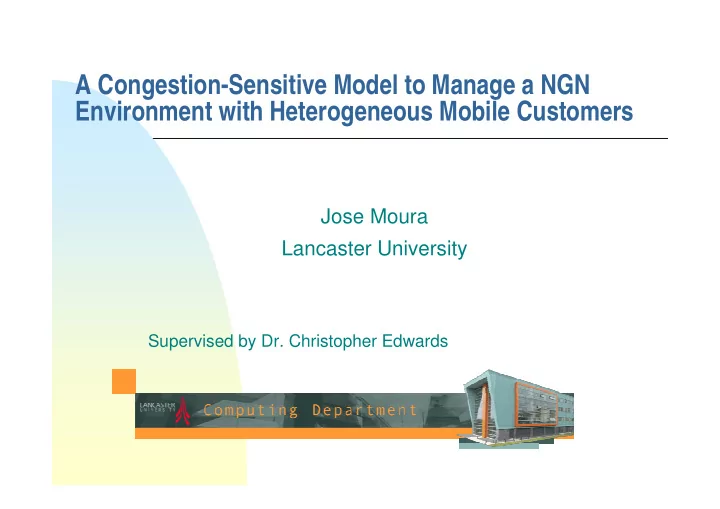

A Congestion-Sensitive Model to Manage a NGN Environment with Heterogeneous Mobile Customers Jose Moura Lancaster University Supervised by Dr. Christopher Edwards
� Agenda: � Motivation � How to deal with Congestion � Work Plan � NGN Model � Business Model � Network Selection � Conclusions � References 2 Jose Moura
Motivation (1) � Next Generation Network (NGN) is a highly dynamic & competitive environment � Increase on the data traffic transported by mobile broadband networks creates a huge stress on the deployed network infrastructure � I aim to address the NGN congestion on the edge of the network � The scenario is a public area (e.g. train station) covered by a heterogeneous wireless network that suddenly becomes congested due to a flash crowd of users that are commuting 3 Jose Moura
Motivation (2) � If the deployed network infrastructure could not conveniently support traffic congestion, then � Unsatisfied users choose an alternative operator � Operator's reputation is degraded � Operator's profit is reduced 4 Jose Moura
How to deal with congestion � Some possible solutions � New access cellular technology (e.g. LTE [1]) � Dynamic spectrum [2] � Problem: Both very expensive because force operator to buy new equipment � So, … 5 Jose Moura
Work Plan � For modelling and solving the congestion problem in the NGN environment: � Develop a model to understand how operators and users should interact [3] � Study a new business model [4] � Study a new network selection scheme [5] 6 Jose Moura
NGN Model (1) � Develop a NGN model using Game Theory [3] � Operators and users have opposite goals � Identify the strategies for each player o operator accepts or blocks user o user stays attached, handovers or leaves � Handover management o signaling overhead o latency o trigger (network vs. terminal) � After the network becomes congested o new user user’s perceived quality user churn operator’s reputation operator’s profit 7 Jose Moura
NGN Model (2) 20,00 15,00 �������� ������� Payoffs 10,00 �������� a13 ������ a23 b12 b13 5,00 ����������������������� 0,00 1 2 3 4 5 6 7 8 9 10 11 12 13 14 15 16 17 18 19 20 N 8 Jose Moura
NGN Model (3) � Model results [3] pointed out some stable vector of players’ strategies, from which no player has any incentive to choose a different strategy, but its stability depends on several aspects, namely network congestion � Results suggest that network stability depends on the way the congestion is controlled � How to control the congestion? 9 Jose Moura
Business Model (1) � Business model characteristics [4]: � uses a dynamic tariff sent to each user through a DHCP/DNS/IPv6 header option mechanism � there is an incentive to enhance user cooperation essentially when network becomes congested � supports heterogeneous users (leisure and business users). Leisure users are price sensitive and business users are quality sensitive � finds the user distribution, constrained by channel capacity, which optimizes operator’s profit � models how channel access contention at MAC layer influences the user’s quality and operator’s profit 10 Jose Moura
Business Model (2) � Results [4] shown that � dynamic tariff offers a maximum operator's profit for a specific channel capacity 25 0,0 200,0 1 5 0,0 S tat_ no p t 1 00,0 S tat_ F a ir_n op t 5 0,0 D yn_ op t 1 0 1 1 1 2 1 3 1 4 1 5 1 6 1 7 1 8 1 9 20 21 22 Channel Capacity (Mbps) � �������������������������������������������������������������������� 11 Jose Moura
Network Selection � Alternative way to attenuate the congestion problem [5] � cooperation between operators + stored historic data predicts congestion occurrence o handover of multimode handsets freeing some strategic Network Attachment Points (NAPs) o some connections downgrade their mode of access technology (e.g. from 3G to GSM) o new customer’s admission is managed between operators � network selection (alternative to signal strength) based on a quality parameter used on each host o distribute the traffic load as best as possible between all local available network attachment points not necessarily from the same technology • For example, beacon delay inspired in SIGCOMM paper [6] 12 Jose Moura
Conclusions � Current conclusions � GT identifies the best strategies for operators and users when they interact in a NGN environment � Wireless congestion could be controlled by o business model o network selection scheme � Future work � We are evaluating how the network selection based on quality deals with the congestion problem � We aim to model and study a business model with two operators 13 Jose Moura
References [1] Ekstrom, H.., et al., Technical Solutions for the 3G Long-Term � Evolution, IEEE Comm. Magazine, vol. 44, no. 3, pp. 38-45, 2006 [2] Zhao, Q., Sadler, B., A survey of dynamic spectrum access, � IEEE Signal Processing Mag., 2007 [3] Moura, J., Dunmore, M., Edwards, C., Next Generation Network � Management of Heterogeneous Mobile Users, In Proc. MobiWac, pp. 111-118, 2008 [4] Moura, J., Dunmore, M., Edwards, C., A Novel Pricing � Approach to Support Heterogeneous Users in Wireless Networks, Under Submission to WMuNeP, 2009 [5] Moura, J., Dunmore, M., Edwards, C., NGN model with � heterogeneous mobile customers, Trilogy Summer School, 2009 [6] Vasudevan, S., et al., Facilitating access point selection in IEEE � 802.11 wireless networks, In Proc. of ACM SIGCOMM Conference on internet Measurement, 2005 14 Jose Moura
Thank you for your attention! Any questions? jose.moura@comp.lancs.ac.uk jose.moura@iscte.pt 15 Jose Moura
Recommend
More recommend